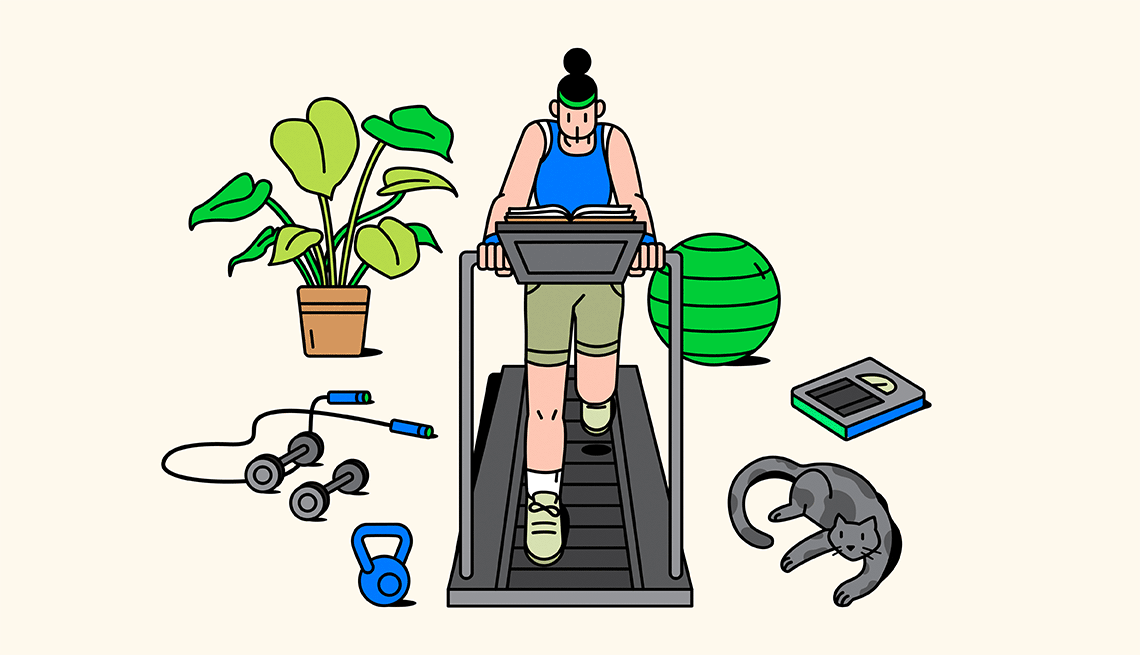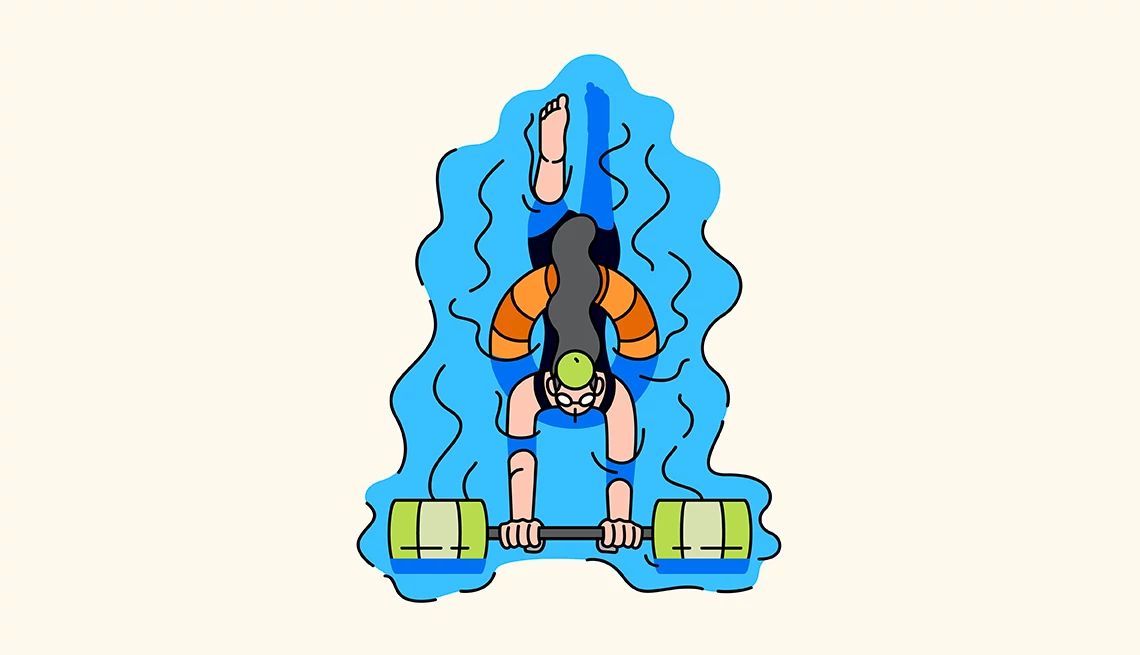AARP Hearing Center


If you think exercise is synonymous with barbells, sweat and the “cha-ching!” of another month’s gym payment being snatched from your wallet, think again. Not only can exercise encompass anything from gardening to pushing your grandkid on the swing, it can also be quite cheap — if not entirely free. Here’s a roundup of 25 great ways to get moving without breaking the bank.
1. Change your mindset
Are you avoiding exercise because you fear (another) injury? Or can’t stop comparing yourself to the younger, fitter you? Or don’t want to commit to hourlong sweat sessions every day, so why bother? You’re not alone, says Michelle Segar, a sustainable behavior change researcher at the University of Michigan and author of The Joy Choice: How to Finally Achieve Lasting Changes in Eating and Exercise.
“We've basically been brainwashed to think in ways that shoot ourselves in the foot before we even walk out the door,” she says. “And so you’ve got to recognize it and not blame yourself.”
First, ask yourself if you want to bring “the incredible gift of movement” into your life in sustainable ways, says Segar. “If the answer is yes, then it’s time to rethink how we think about exercise.” After all, research shows that embracing a growth mindset — a belief that you can change — toward exercise makes you more likely to believe you can do it, you deserve to do it and you will do it.
2. Swap some sitting time with movement
Substitute some of your sedentary time with light movement, recommends Loretta DiPietro, a professor of exercise and nutrition sciences at George Washington University’s Milken Institute School of Public Health. Try marching in place during commercial breaks or doing laps around the office between tasks. If you have mobility issues, simply go from sitting to standing multiple times a day, or bicycle your legs in the air while seated.
“People think, ‘I have to go to the gym and sweat,’” DiPietro says. But there’s now “enough evidence to suggest that replacing sitting time with light-intensity activity is extremely beneficial.”
Even better if you can add in short bouts of more intense exercise. One study found that 19 minutes of vigorous exercise a week — that’s less than three minutes a day — is associated with a whopping 40 percent lower risk of developing heart disease, as well as a lower risk of cancer and improved longevity. Got 60 seconds? Check out 1-Minute Exercises to Make You Stronger After Age 50.
3. Walk
Experts agree that the best exercise is the one you enjoy and will stick with. But, Segar says, “if you could judge something as the best exercise for motivation and for more people, it would be walking.”
After all, regular walking has been shown to decrease the risk or severity of age-related conditions including heart disease, dementia and type 2 diabetes, while improving mental well-being, sleep and longevity.
So decide on your aim. To help control blood sugar, walk after meals. To improve bone density, walk with hand weights, a weighted vest or a backpack filled with books, DiPietro suggests. To foster social connections — which themselves are linked to enhanced physical and mental health — check out an organization like the American Volkssport Association, which hosts over 200 free walking clubs nationwide.
4. Walk with a doc
If your aim is academic in nature, link up with Walk with a Doc, which has more than 500 chapters across the United States and around the world. Each hourlong free community stroll is led by a medical professional who starts the group saunter by discussing a health topic.
Even walking on your own can boost brainpower, though. A study in the journal JAMA Neurology found that walking at least 3,800 steps a day is linked to a 25 percent decreased risk of dementia. Walking 9,800 steps daily, meanwhile, may reduce the risk by 50 percent.
“Every time we move our body, we are getting miracle growth for our brain in the form of BDNF,” or brain-derived neurotrophic factor, a protein that helps neurons survive and grow, says Melissa Sundermann, a double board-certified physician in internal medicine and lifestyle medicine.


5. Go birding
Birdwatching is another way to reap the rewards of the great outdoors. Not only does the hobby encourage you to move your body in nature, it also prompts you to engage your brain and oftentimes connect with other people, Sundermann says. Research on pandemic-era birders also found that simply seeing or hearing birds can improve mental well-being for up to eight hours.
Many communities have free birding walks or clubs; check out an Audubon Center or Sanctuary near you. Membership to the American Birding Association, which connects participants with educational resources and other birders, starts at just $30 a year. Learn more in A Beginner’s Guide to Birding. Want to listen on your own? Check out our 4 Apps to Help You Identify Bird Calls.
6. Adopt this mantra: 'Everything counts'
Before looking for fresh ways to get your blood pumping, appreciate what you’re doing right now, Segar suggests. Are you a librarian or teacher who’s frequently standing, kneeling and carrying books? Great! Are you the family chef who hauls groceries, reaches for pots and stirs sauces? That counts! Do you live in a city and walk to and from a bus stop daily? That counts, too.
Per the Physical Activity Guidelines for Americans, adults should aim to get at least 150 minutes of moderate-intensity exercise throughout the week. That could look like hitting the elliptical for 30 minutes every weekday, but it can also include a combination of many of your current daily tasks.
“What I’ve found over the years is that when people … already have a lot built in that they’ve been doing anyway, and they can now recognize it as, ‘Wow, this counts,’ it opens them,” says Segar. “Then they say, ‘What else can I do?’”
7. Get outside
The benefits of walking only compound if you do so in nature, says Sundermann, who’s based in Michigan and is known as “Doctor Outdoors.”
Research shows that a day trip to a forest increases the body’s natural killer or infection-fighting cells, as well as anti-cancer proteins, for up to a week. In some instances, the benefits — including reductions in the stress hormone cortisol and blood pressure — lasted a month. That’s partly because trees release phytoncides, chemicals that can boost the immune system.
Optimizing your immune system is important not only to fight infection but also to reduce inflammation. “Inflammation is tied to insulin resistance, tied to coronary artery disease, tied to autoimmune disease, tied to dementia, tied to obesity,” Sundermann says. “So moving our bodies in green spaces, we get that benefit.”
8. Move through beautiful scenery
Turn your time in nature into a trip by visiting one of the National Parks Service’s 400-plus units nationwide. Many parks also provide idyllic settings for biking, paddling or visiting a museum; some offer snowshoeing, swimming and fishing. Take advantage of one of the free national park days throughout the year. And if you are a U.S. resident age 62 or older, you’re in luck: The system offers a 2025 pass for just $20, and a lifetime pass for just $80.
State parks, which can be cheaper and less crowded than national parks, can be a good option, too. The state of Georgia offers 50 percent off its annual pass of $50 to visitors who are at least 62 years old.





































































You Might Also Like
#1 Belly Fat Exercise
How to relieve back pain, improve posture and balance and make your belly fat healthier
Yoga Poses to Fight Osteoporosis
Build bone mass with these five easy moves
AARP Smart Guide to Muscle Health
30 ways to maintain your strength as you age